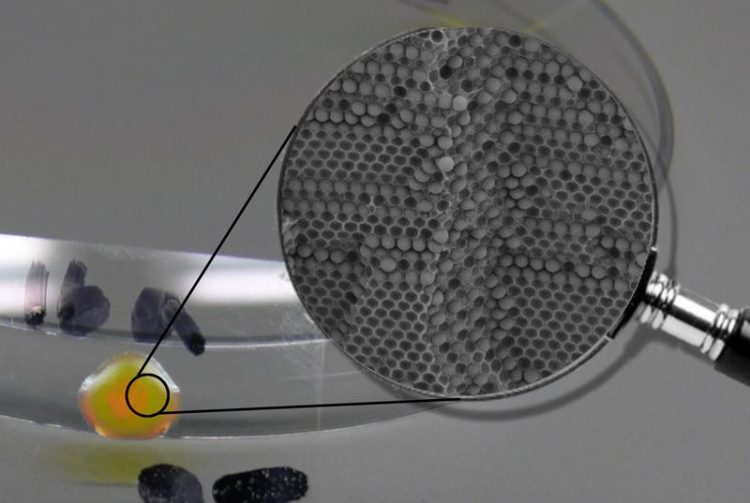Artificial gemstones for telecommunication

Printed opals and their particle structure as visualized by electron microscopy Figure: A. Kühne / DWI
Inspired by the interaction of opals with light, Dr. Alexander Kühne investigates and develops artificial opals for future applications in the fields of telecommunication, photonics and biomedicine. His efforts find appreciation: The Federal Ministry of Education and Research (BMBF) now decided to fund Alexander Kühne’s junior research group at DWI – Leibniz Institute for Interactive Materials. The total funding amount is one million euros and covers a period of four years.
Opals – both natural and artificial ones – consist of small particles that can alter light waves. For example, they reflect light of a certain wavelength, whereas light of a different wavelength can pass. In his group, Alexander Kühne prepares such particles in a sophisticated chemical procedure. Subsequently, the group members use a spinning method to prepare light-conducting fibers, in which the particles assemble in the core.
Alternatively, they can use ink jet printing to position the particles on a surface. Both techniques are based on the property of the particles to self-assemble into regular crystalline structures just like in natural opals. “With our particle system, we combine three distinct ways of interaction with light,” 33-year-old Kühne explains. “Light absorption like in dyes and pigments, emission using the fluorescence effect, and reflection occurring from the regular structure of the assembled particles.”
“In the future, our materials may play a significant role as manipulators in light-guiding data cables. They might contribute to faster, more efficient ways of data transfer. In addition, they could be used as printable forgery protection labels, on packaging of drugs and vaccines.“ However, current challenges for Kühne and his team are still a few steps away from application: “We are trying to create high numbers of particles with uniform size and morphology. Besides, we are working on combining several fluorescent colors within one system.“
Alexander Kühne studied chemistry in Cologne and Glasgow and did his PhD in the group of Richard Pethrick at the University of Strathclyde in Glasgow. After postdoc positions in the labs of Klaus Meerholz (Cologne) and David Weitz (Harvard), he moved back to Germany and joined DWI in 2011. His current research is based on his experience with nano-structured polymer films for organic lasers.
Media Contact
All latest news from the category: Materials Sciences
Materials management deals with the research, development, manufacturing and processing of raw and industrial materials. Key aspects here are biological and medical issues, which play an increasingly important role in this field.
innovations-report offers in-depth articles related to the development and application of materials and the structure and properties of new materials.
Newest articles

High-energy-density aqueous battery based on halogen multi-electron transfer
Traditional non-aqueous lithium-ion batteries have a high energy density, but their safety is compromised due to the flammable organic electrolytes they utilize. Aqueous batteries use water as the solvent for…

First-ever combined heart pump and pig kidney transplant
…gives new hope to patient with terminal illness. Surgeons at NYU Langone Health performed the first-ever combined mechanical heart pump and gene-edited pig kidney transplant surgery in a 54-year-old woman…

Biophysics: Testing how well biomarkers work
LMU researchers have developed a method to determine how reliably target proteins can be labeled using super-resolution fluorescence microscopy. Modern microscopy techniques make it possible to examine the inner workings…





















